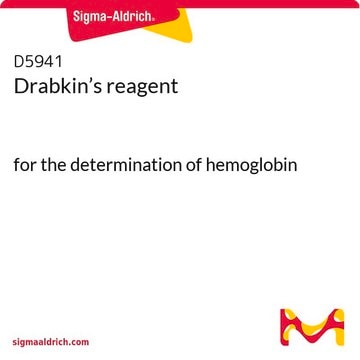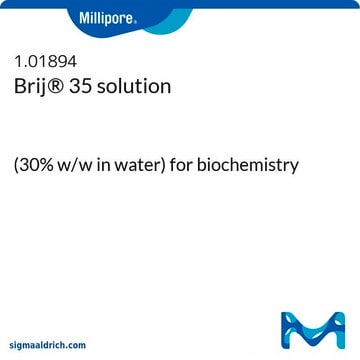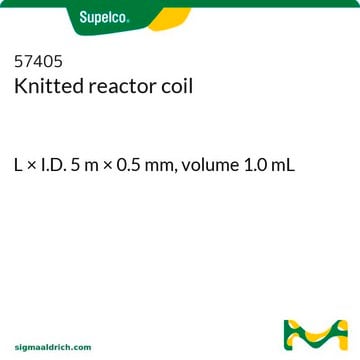If this product has an expiration or retest date, it will be shown on the Certificate of Analysis (COA, CofA). If there is no retest or expiration date listed on the product's COA, we do not have suitable stability data to determine a shelf life. For these products, the only date on the COA will be the release date; a retest, expiration, or use-by-date will not be displayed.
For all products, we recommend handling per defined conditions as printed in our product literature and website product descriptions. We recommend that products should be routinely inspected by customers to ensure they perform as expected.
For products without retest or expiration dates, our standard warranty of 1 year from the date of shipment is applicable.
For more information, please refer to the Product Dating Information document: https://www.sigmaaldrich.com/deepweb/assets/sigmaaldrich/marketing/global/documents/449/386/product-dating-information-mk.pdf
B4184
Brij® L23 solution
30 % (w/v) in H2O
Sinónimos:
C12E23
Seleccione un Tamaño
68,30 €
Seleccione un Tamaño
About This Item
68,30 €
Productos recomendados
origen biológico
synthetic
Nivel de calidad
descripción
non-ionic
Formulario
liquid
mol peso
~1198.0 g/mol
concentración
30 % (w/v) in H2O
número de agregación
40
CMC
91 μM
temperatura de transición
cloud point ≥100 °C
solubilidad
water: soluble
densidad
1.024 g/mL
HLB
16.9
cadena SMILES
CCCCCCCCCCCCOCCOCCOCCOCCOCCOCCOCCOCCOCCOCCOCCOCCOCCOCCOCCOCCOCCOCCOCCOCCOCCOCCOCCO
InChI
1S/C58H118O24/c1-2-3-4-5-6-7-8-9-10-11-13-60-15-17-62-19-21-64-23-25-66-27-29-68-31-33-70-35-37-72-39-41-74-43-45-76-47-49-78-51-53-80-55-57-82-58-56-81-54-52-79-50-48-77-46-44-75-42-40-73-38-36-71-34-32-69-30-28-67-26-24-65-22-20-63-18-16-61-14-12-59/h59H,2-58H2,1H3
Clave InChI
IEQAICDLOKRSRL-UHFFFAOYSA-N
¿Está buscando productos similares? Visita Guía de comparación de productos
Categorías relacionadas
Descripción general
Aplicación
- as a supplement of De Man, Rogosa, Sharpe (MRS) broth for monitoring bacteriocin production by lactic acid bacteria(66)
- as a component of developing buffer for the incubation of zymogram gel for metalloproteinase quantification(67)
- as a component of activation buffer for recombinant human hepsin(68)
Acciones bioquímicas o fisiológicas
Características y beneficios
Envase
Nota de preparación
Otras notas
Información legal
producto comparable
Palabra de señalización
Warning
Frases de peligro
Consejos de prudencia
Clasificaciones de peligro
Aquatic Chronic 2 - Eye Irrit. 2 - Skin Irrit. 2
Código de clase de almacenamiento
10 - Combustible liquids
Clase de riesgo para el agua (WGK)
WGK 2
Punto de inflamabilidad (°F)
Not applicable
Punto de inflamabilidad (°C)
Not applicable
Elija entre una de las versiones más recientes:
Certificados de análisis (COA)
¿No ve la versión correcta?
Si necesita una versión concreta, puede buscar un certificado específico por el número de lote.
¿Ya tiene este producto?
Encuentre la documentación para los productos que ha comprado recientemente en la Biblioteca de documentos.
Los clientes también vieron
Artículos
Cathepsin B is a lysosomal cysteine proteinase with broad specificity. This protocol uses Nα–CBZ–Arg–Arg–7–amido–4–methylcoumarin as the substrate for fluorometric detection of Cathepsin B activity.
-
How can I determine the shelf life / expiration / retest date of this product?
1 respuesta-
¿Le ha resultado útil?
-
-
How is shipping temperature determined? And how is it related to the product storage temperature?
1 respuesta-
Products may be shipped at a different temperature than the recommended long-term storage temperature. If the product quality is sensitive to short-term exposure to conditions other than the recommended long-term storage, it will be shipped on wet or dry-ice. If the product quality is NOT affected by short-term exposure to conditions other than the recommended long-term storage, it will be shipped at ambient temperature. As shipping routes are configured for minimum transit times, shipping at ambient temperature helps control shipping costs for our customers. For more information, please refer to the Storage and Transport Conditions document: https://www.sigmaaldrich.com/deepweb/assets/sigmaaldrich/marketing/global/documents/316/622/storage-transport-conditions-mk.pdf
¿Le ha resultado útil?
-
Filtros activos
Nuestro equipo de científicos tiene experiencia en todas las áreas de investigación: Ciencias de la vida, Ciencia de los materiales, Síntesis química, Cromatografía, Analítica y muchas otras.
Póngase en contacto con el Servicio técnico











